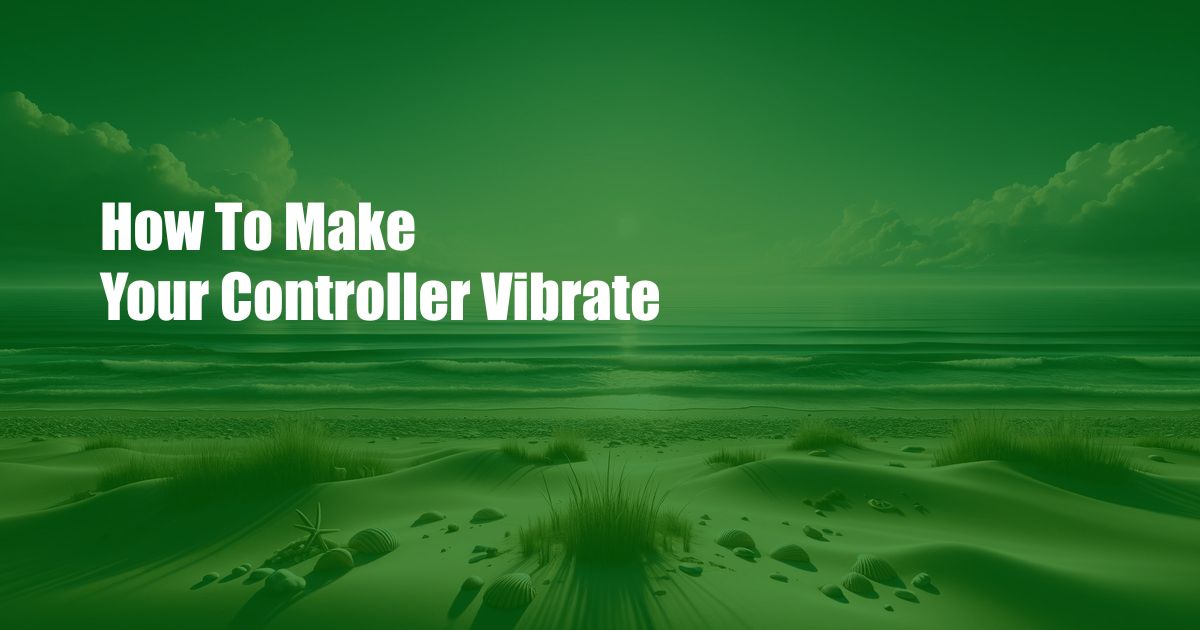
How to Make Your Controller Vibrate: A Comprehensive Guide
In the realm of gaming, tactile feedback is paramount in immersing players in the virtual world. Vibrating controllers have revolutionized this experience, providing an extra layer of intensity and realism. From the gentle hum of a heartbeat to the explosive roar of a gunshot, these vibrations can amplify the gaming experience like never before.
Whether you’re a seasoned gamer or a novice just starting out, understanding how to control your controller’s vibrations will elevate your gaming experience. In this comprehensive guide, we’ll delve into the world of controller vibrations, exploring their history, purpose, and the latest trends. Moreover, we’ll provide expert advice and practical tips to help you optimize this feature for an unforgettable gaming journey.
A History of Controller Vibrations: From Humble Beginnings to Advanced Technology
The genesis of controller vibrations can be traced back to the humble beginnings of gaming. In 1997, the Nintendo 64 introduced the Rumble Pak, an add-on device that attached to the controller and generated vibrations. This revolutionary concept opened the door to a new era of gameplay, where players could physically feel the impact of their actions.
Since then, controller vibrations have evolved significantly. Modern controllers, such as the PlayStation 5’s DualSense and Xbox Series X’s Wireless Controller, utilize haptic feedback technology for an even more precise and immersive experience. These controllers can generate vibrations that simulate a wide range of sensations, from subtle textures to powerful explosions, enhancing the player’s connection to the game world.
The Science Behind Controller Vibrations: Understanding Haptics and Force Feedback
At the heart of controller vibrations lies a fascinating interplay of haptic feedback and force feedback. Haptics refers to the sense of touch and the ability to perceive vibrations. Force feedback, on the other hand, is the sensation of resistance or movement when interacting with a physical object.
Modern controllers combine these two technologies to create realistic and immersive vibrations. Haptic motors generate the vibrations, which are then transmitted to the player’s hands through the controller. These vibrations can vary in intensity, frequency, and duration, allowing developers to create a wide range of sensory experiences.
Customizing Controller Vibrations: Tailoring the Experience to Your Preferences
Many modern controllers offer customizable vibration settings, empowering players to fine-tune the intensity and vibration patterns to their liking. This customization is essential for optimizing the gaming experience and adapting it to individual preferences.
To adjust the vibration settings, navigate to the controller options menu within your gaming console or PC. Here, you’ll typically find sliders or toggles that allow you to control the overall vibration intensity, as well as the vibration strength for specific triggers or buttons. Experiment with these settings until you find the perfect balance for your gaming needs.
Expert Tips for Maximizing Controller Vibrations: Enhancing the Immersion and Realism
To fully harness the potential of controller vibrations, consider these expert tips:
- Use quality headphones: Vibrations are best experienced when combined with high-quality headphones. Headphones provide immersive audio that complements the tactile feedback, creating a truly enveloping gaming experience.
- Calibrate your controller: Calibration ensures that the controller’s vibrations are accurately calibrated, delivering the optimal experience for each game. Refer to your controller’s manual for specific calibration instructions.
- Experiment with different vibration patterns: Most modern controllers allow you to customize the vibration patterns for different actions and triggers. Experiment with these settings to find the ones that enhance your gameplay the most.
Frequently Asked Questions: Unraveling Common Queries
Q: How do I turn off controller vibrations?
A: Vibration settings can typically be adjusted in the controller options menu within your gaming console or PC. Simply navigate to the settings, locate the vibration controls, and disable the vibrations.
Q: Why are my controller vibrations weak or inconsistent?
A: Weak or inconsistent vibrations could indicate a problem with the controller’s haptic motors or wiring. Try cleaning the controller or connecting it to a different USB port to troubleshoot the issue.
Conclusion
Controller vibrations have become an integral part of the gaming experience, adding an extra layer of immersion and realism. By understanding the history, science, and customization options of controller vibrations, you can optimize this feature to enhance your gameplay and dive deeper into the virtual worlds you explore.
So, embrace the power of vibrations and let your gaming senses come alive. Experiment with different settings, listen closely to the subtle nuances, and revel in the immersive experience that controller vibrations bring to your gaming journey. Are you ready to take your gaming to the next level with the full force of controller vibrations?

 Hogki.com Trusted Information and Education News Media
Hogki.com Trusted Information and Education News Media